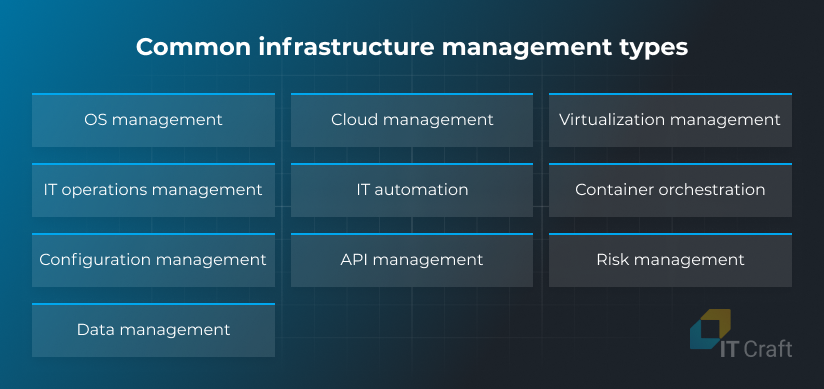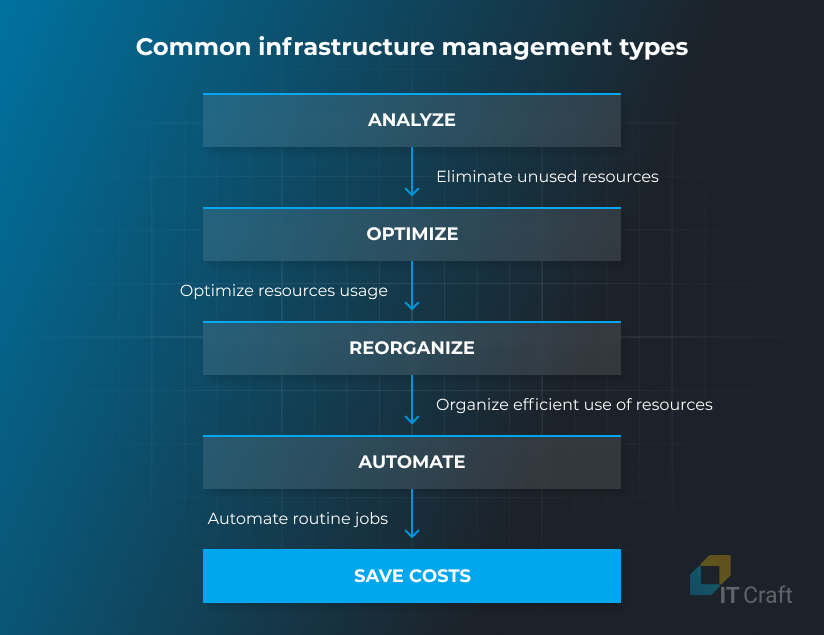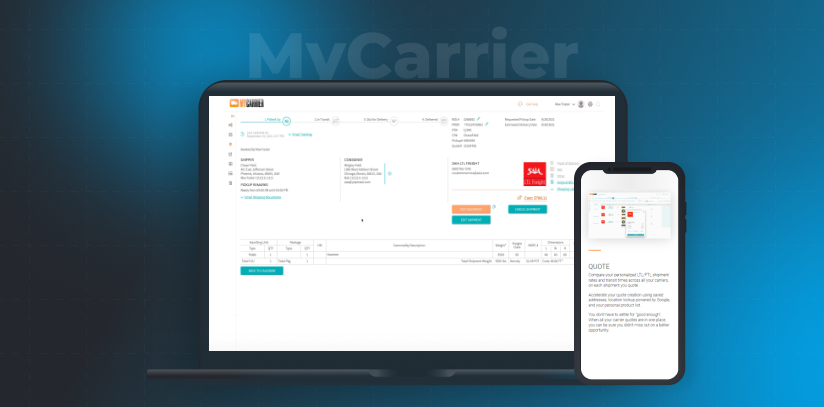IT infrastructure optimization is an integral ingredient in growing your business. When left unattended, what was once a fast and elegant solution becomes slow and clumsy.
Here are a few signs you should prioritize optimization:
IT infrastructure optimization is an integral ingredient in growing your business. When left unattended, what was once a fast and elegant solution becomes slow and clumsy.
Here are a few signs you should prioritize optimization:
Read how you can tackle infrastructure optimization and keep it in line with your ever-evolving business needs.
The cost of no action? Lack of stability and skyrocketing maintenance expenses.
According to Flexera Tech Spend Pulse reports, key tech initiatives remain the same for 2020, 2021, and 2022: digital transformation, cybersecurity, and cloud/cloud migration.
These three aspects shape optimization strategies:
Digital transformation
IT infrastructure architecture directly affects the optimization model. For instance, available optimization options are limited for on-premises solutions (as opposed to SaaS solutions). To remain relevant, businesses need to blend new technologies into their processes. Digital transformation adjusts less-than-perfect processes, so they can efficiently and effectively keep pace with your growing business demands.
Cybersecurity
Infrastructure is a potential treasure trove for all cyber criminals. Correct setup, proper maintenance, and timely updates are crucial for meeting high-security standards and keeping cyber criminals out.
Cloud/cloud migration
Cloud migration has positive long-term effects. Software quality increases while keeping costs the same or lower. Businesses improve performance by focusing on automation, AI, and efficient scaling.
Why do businesses hesitate when it comes to IT infrastructure optimization?
1. A comprehensive view of software is complicated. IT infrastructure management requires accurate coordination of the following:
2. Engineers apply several management types on maintenance projects:

3. Every business has its own unique optimization path. Each path is determined by goals and current infrastructure setups.
Optimum IT infrastructures share the following characteristics:
A DevOps team is responsible for system optimization on a project. For flexible resource management, many options are available. The team determines the relevant path to cost effectiveness and implements it.
IT infrastructure optimization requires three important steps:
Audit
Optimization starts with a comprehensive project audit.
1. The team analyzes current costs.
2. It maps the spending structure to detect resources the system no longer needs or uses.
3. It also analyzes infrastructure for bottlenecks and areas needing improvement.
Planning
The DevOps team frames the best infrastructure optimization model. It decides on priorities outlining both immediate and long-term value.
DevOps engineers provide a step-by-step reorganization plan that does not affect system users.
The team also thinks of metrics that would be useful for controlling expenses and monitoring system health.
An important note. Expect a large scope of work when planning to move an on-premises app to the cloud. You might need a development team to divide a monolith into user-friendly microservices.
Implementation
When the plan is ready and approved, the team goes iteration by iteration through four main stages:
Optimize. The team focuses on optimization by eliminating sources of wasted costs. These include unused server resources, forgotten artifacts, imbalanced server configurations, and more.
Reorganize. The DevOps team uses audit information for correct server sizing. It balances costs and uptime. Engineers reserve resources capacity when needed.
Automate. DevOps focus on the automation of routine jobs. Manual processes are one of the primary sources of increased infrastructure costs.
Monitor. The DevOps team fine-tunes metrics to better understand and manage maintenance expenditures. Cloud providers offer tools for transparent cost calculation, e.g., AWS Cost Explorer.
 Source: https://itechcraft.com/blog/clients-amazon-aws-hosting/
Source: https://itechcraft.com/blog/clients-amazon-aws-hosting/
An important note. Continuous improvement is essential. For best results, businesses should carry out an audit every six months.
A regular revision of goals and applied metrics is a part of an audit. This way, businesses ensure they pay only for the necessary resources.
Median optimization expenses amount to 8% of revenue. Small companies pay 10%, while large enterprises reduce costs to 6%.
Why?
The latter address optimization challenges more effectively.
Consider the following challenges.
Clarity
Businesses must have a basic understanding of their tech needs.
They must establish clear goals. It then becomes easier to determine what resources engineers can cut or redistribute.
Otherwise, the team might focus on an irrelevant infrastructure design.
Urgency
Often, businesses consider optimization when their software stops performing well. The system is slow. Crashes occur constantly.
Although businesses might expect an immediate improvement, it might not be possible. Problems tend to hide below the surface. This includes accumulated tech debt, obsolete technologies, scarce scalability, etc.
The team might initiate software modernization. This takes time—much longer than anticipated.
Engineering talents
Expertise makes the difference. Yet, hiring DevOps talents is problematic due to specific responsibilities: DevOps focuses on constant innovation and improvement.
To keep pace with industry leaders, small companies can engage external experts. A reputable IT infrastructure optimization company is a viable alternative. A business receives experts in DevOps services ready for an immediate start and at a fair price.
Understanding costs of delivered services
It is important to recognize the value of optimization. Besides a direct cost decrease, indirect improvements apply, affecting the costs of software ownership—for instance, increased code quality.
A side effect is also possible. Growing businesses use more resources. They increase total expenditures and get an impression of unoptimized resource usage.
Therefore, it is vital to set up relevant metrics and interpret them accurately.
When businesses invest in IT infrastructure optimization, they get:
A lower degree of wasted spend
Direct costs are the main benefit. By decreasing wasted spending, businesses reallocate resources, creating more value, e.g., delivering new features faster. Development departments remain effective even with flat or lower budgets.
Software stability and scalability
Software performance improves. The system is capable of handling more user requests. It is easy to deploy many identical instances to handle user influx.
Teamwork automation
Automation decreases time to production, while deployments require little attention from developers. The team focuses on business-value delivery instead of constantly fixing issues. There are consistent deliveries.
Improved control over expenses
Infrastructure management is simplified. It is easier to control expenses when businesses access various instruments and metrics. For instance, the maintenance team detects spikes in costs or unused resources.
Overhead reduction
When switching to a cloud solution, businesses get fewer items on their expenditures list. They do not need to buy, rent, or upgrade the server hardware. They do not rent extra space nor pay the data center’s electricity bills. Updates and licensing occur on the provider’s side.
Businesses spend time and resources on priority activities.
The long-term results of optimization are:
This logistics portal enjoys popularity among end users. It enables direct, transparent communication between clients and service providers.
Stable growth of the user base determined the portal’s further development direction. The team transformed monolith, on-premises software into a microservices-based cloud solution. The team designed and implemented a three-step plan ensuring an uninterrupted end-user experience.

IT Craft offers individual terms to meet every client’s unique needs.
Our engineers and managers discuss all project details before beginning implementation.
Here is how optimization starts:
Initial call
Schedule an initial call with our project managers and lead engineers.
We discuss your concerns and challenges during the initial call:
This information helps us better understand and document your needs.
Analysis and planning
Our team studies requirements. It dives into specific details to determine improvement areas. It also prepares a high-level cost estimate. The estimate includes the scope of work, licensing, and subscriptions for required third-party services.
Cooperation details
We discuss terms of cooperation that allow consistent deliveries for the best possible price. We agree on deliverables, metrics, payment terms, and other essential details.
Project kick-off
Once we have elaborated the implementation plan and cooperation details, the team starts without delay.
Infrastructure optimization decreases wasted spending. Businesses that invest in optimization allocate costs more effectively.
Businesses need to be wise about optimization possibilities. To decrease expenditures, they need to:
Not enough resources to cover the needs with internal expertise? It is worth considering a partnership with an established provider.
Major IT infrastructure components include:
Three common types of IT infrastructure include: